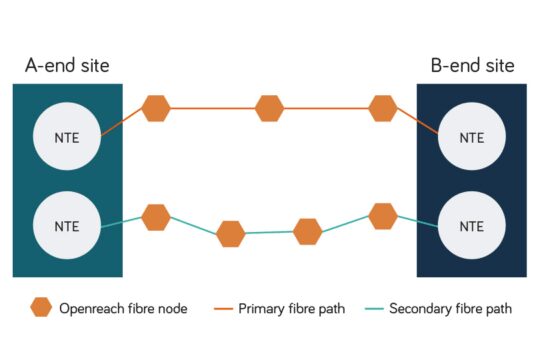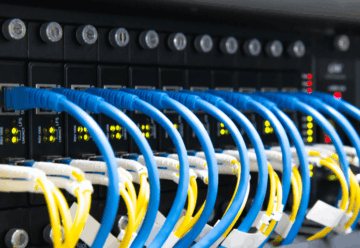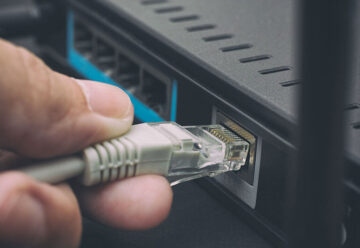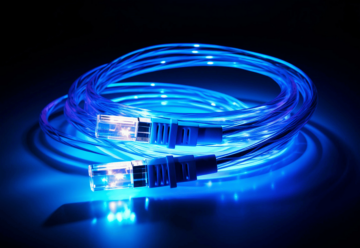Business Ethernet
Resilient, high-bandwidth connectivity for your business
What is RO2?
RO2 (Resilience Option 2) is an Openreach service that provides two physically separate fibre paths in the last mile, the access network connecting your business to your network service provider’s core network. Combined with the right failover, RO2 helps protect against single points of failure. If one path fails due to cable damage, roadworks, exchange faults or node outages, traffic automatically switches to the second.
RO2 offers end-to-end physical separation from building entry to exchange node, giving a higher level of protection than standard dual-circuit setups. It’s the only Openreach-supported method that guarantees diverse routing between two circuits, and it’s available for both Ethernet and optical services.
As a key part of network resilience strategies, RO2 is used by enterprises, financial institutions and other data-intensive organisations where uptime is critical.
How does RO2 work?
RO2 provides two completely separate fibre routes between sites: a primary and a secondary path. Each circuit is built through different ducts, cables and building entry points wherever possible, so a single local incident won’t take both routes down.
Each circuit terminates in its own Network Terminating Equipment (NTE) at both ends, meaning there are no shared physical components between the two paths.
RO2 (Resilience Option 2)
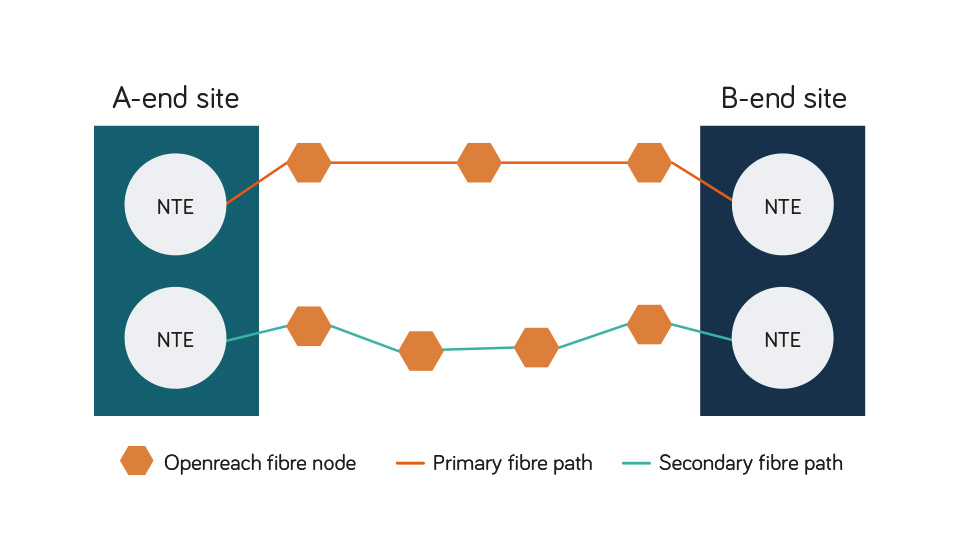
Where available, circuits are also routed via different Openreach access nodes or exchanges, protecting your service from local exchange or node failures.
You or your connectivity provider decides how traffic moves between the two routes. Most businesses use automatic failover built into routers, firewalls or SD-WAN controllers. If the primary circuit is disrupted, traffic automatically switches to the secondary.
Protection should also continue through the provider’s core network, avoiding shared backhaul routes.
For example, with Neos Networks Business Ethernet, your network is routed through our diverse MPLS network. Self-healing and rerouting mean resilience is built in. For optical connectivity, you can configure diverse routes across our core network.
Because RO2 involves separate routing, a site survey is always needed to confirm viable routes and any excess construction charges (ECCs) before installation.
Why does RO2 matter for your business?
In 2024, 72% of senior UK IT decision-makers said that inadequate resilience led to disruption or downtime.
Downtime costs money. It can disrupt operations, break SLAs and damage reputations. Even short outages can affect customer experience, compliance or productivity.
RO2 matters because it’s the only Openreach-supported way to guarantee true end-to-end diversity between two circuits.
Ordering two circuits separately (even from different providers) doesn’t guarantee resilience. They often share ducts, exchanges or backhaul routes. As Openreach controls the access network, only RO2 can ensure full physical separation at the infrastructure level.
If your operations are mission-critical, time-sensitive or regulated, RO2 provides assured physical diversity in the Openreach access network.
What are the benefits of RO2?
Here’s how RO2 strengthens your network and supports your business.
| Benefit | What it means for your business |
| End-to-end physical diversity | No shared ducts, cables or exchanges, from building entry to core network. Eliminates single points of failure across your wider network. |
| Maximum uptime and business continuity | Minimises network disruption during faults, engineering works or local outages, helping to prevent costly downtime. |
| Supports compliance and SLAs | Underpins trust and brand reliability for always-on services. Supports SLAs and regulatory uptime obligations in sectors like finance, health care and government. |
| Flexible design options | Can be configured for the same site, split-site or dual-site resilience (see below for details). Available across Ethernet and optical services to suit different bandwidths and latency requirements. |
| Long-term value | May require higher upfront installation cost but mitigates potential future losses from outages. |
How to implement RO2 with your provider
When planning RO2 with your connectivity provider, it’s important to know what to ask for. Here are some key questions to confirm before going ahead.
What kind of resilience do you need?
Start by identifying where your network is most vulnerable. Do you need complete end-to-end diversity? Your provider should help assess which areas need diversity most based on your risk profile, network setup and location – from your local site to the access node, exchange and core network.
Which services will you use RO2 for?
RO2 is available for a range of Ethernet and optical services. Your provider should help you choose the right product based on bandwidth, latency and site requirements.
Here’s how RO2 strengthens your network and supports your business.
| Service type | Use case |
| Ethernet Access Direct (EAD) | Most common RO2 deployment. Suitable for high capacity business connectivity. |
| Ethernet Backhaul Direct (EBD) | Used for aggregating multiple Ethernet circuits. RO2 adds resilience to backhaul routes. |
| Optical Spectrum Access (OSA) | Ideal for ultra-low latency and high-bandwidth applications. RO2 ensures physical diversity. |
| Optical Spectrum Extended Access (OSEA) | Extends OSA reach. RO2 protects long-distance optical connectivity. |
How should you configure the A-end and B-end of your connection?
RO2 supports three configurations depending on your site layout and resilience needs:
- Same-site configuration: Both circuits run between the same A-end and B-end locations.
- Split-site configuration: Circuits share the same A-end but terminate at two different B-end sites.
- Dual-site configuration: Circuits terminate at different A-end and B-end locations.
Your provider should help you choose the right setup based on your business continuity strategy and network design.
Can your provider guarantee full physical separation?
Ask for confirmation that both circuits take completely independent routes. Only RO2 delivered by Openreach guarantees this level of resilience, avoiding shared ducts, exchanges and backhaul routes.
Will the circuits be routed through different Openreach access nodes or exchanges?
RO2 can route circuits via separate Openreach exchanges or access nodes, depending on availability and location. This protects you against local exchange or node failures.
Will each circuit have its own Network Terminating Equipment (NTE)?
Each RO2 circuit should terminate on independent NTEs, so a single equipment fault doesn’t affect both services.
How is traffic switched between the primary and secondary circuits?
Will you or your provider manage the failover? Most organisations use automatic failover through routers, firewalls or SD-WAN.
RO2 vs other diversity options
RO2 gives you route and exchange diversity in the access layer, removing single points of failure between your sites and the network. But it’s just one part of a wider Ethernet resilience strategy.
To build complete end-to-end resilience, combine RO2 with other design principles such as dual-homing, router redundancy, shadow VLANs, DDoS resilience and core network resilience.
Learn more about Ethernet resilience and diversity
Is RO2 right for your business?
If downtime isn’t an option for your business, RO2 is worth considering as part of your wider network resilience strategy. It’s ideal for:
- Financial services, healthcare, utilities and media organisations that rely on always-on connectivity and strict uptime SLAs
- Data centre operators and cloud providers needing resilient, high-capacity last-mile links
- Public sector and emergency services where network continuity supports essential services and compliance
- Organisations with mission-critical operations where even short outages can cause major disruption or financial loss
If you’re exploring resilience options for your network, Neos Networks can help. As a UK Critical National Infrastructure provider, supporting everything from energy to emergency services, we understand RO2 – the vital role it plays in delivering resilience for critical networks.
With over 600 PoPs and 90 data centres on-net, we deliver true end-to-end diversity across Ethernet and optical services nationwide. Our pre-sales team can help design a resilience solution that fits your network architecture and business goals.
Business Ethernet
Resilient, high-bandwidth connectivity for your business
